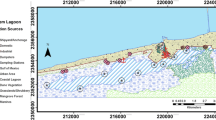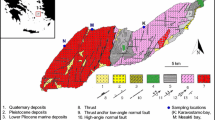Abstract
Study on contamination of tsunami sediments deposited on 26 December 2004 conducted shortly after the tsunami in coastal zone of Thailand revealed elevated contents of salts in water-soluble and some heavy metals and arsenic in bioavailable fractions (Szczuciński et al. in Env Geol 49:321–331, 2005). Few months later rainy season started and effected in total rainfall of over 3,300 mm. This paper presents results of survey repeated 1 year after the tsunami. To assess the effects of rainy season on mobilization of previously determined potential contaminants, the same locations were sampled again and analysed with the same methods. The tsunami deposit layer was well preserved but in many locations the sediments were coarser than just after tsunami due to washing out of finer fractions. The water-soluble salts contents were strongly reduced after the rainy season. However, the concentrations of acid leachable heavy metals and metalloids were still elevated in comparison to reference sample from an area not impacted by tsunami. It is possible that the metals and metalloids are successively moved to more bioavailable fraction from forms which were more resistant to mobilization.



Similar content being viewed by others
References
Babu N, Suresh Babu DS, Mohan Das PN (2007) Impact of tsunami on texture and mineralogy of a major placer deposit in southwest coast of India. Environ Geol. doi: /s00254-006-0450-7 (in press)
Bell R, Cowan H, Dalziell E, Evans N, O’Leary M, Rush B, Yule L (2005) Survey of impacts on the Andaman Coast, Southern Thailand following the great Sumatra-Andaman earthquake and tsunami of December 26, 2004. Bull NZ Soc Earthquake Eng 38(3):123–148
Bishop P, Sanderson D, Hansom J, Chaimanee N (2005) Age-dating of tsunami deposits: lessons from the 26 December 2004 tsunami in Thailand. Geograph J 171(4):379–384
Boszke L, Kowalski A, Szczuciński W, Rachlewicz G, Lorenc S, Siepak J (2006) Assessment of mercury mobility and bioavailability by fractionation method in sediments from coastal zone inundated by the 26 December 2004 tsunami in Thailand. . Environ Geol 51:527–536
Chagué-Goff C, Goff JR (1999) Geochemical and sedimentological signature of catastrophic saltwater inundations (tsunami), New Zealand. Quat Aust 17:38–48
Chague-Goff C, Dawson S, Goff JR, Zachariasen J, Berryman KR, Garnett DL, Waldron HM, Mildenhall DC (2002) A tsunami (ca. 6,300 years BP) and other Holocene environmental changes, northern Hawke’s Bay, New Zealand. Sediment Geol 150(1–2):89–102
Chaudhary DR, Gosh A, Patolia JS (2006) Characterization of soils in the tsunami-affected coastal areas of Tamil Nadu for agronomic rehabilitation. Current Sci 91(1):99–104
Choi BH, Hong SJ, Pelinovsky E (2006) Distribution of runup heights of the December 26, 2004 tsunami in the Indian Ocean. Geoph Res Lett 33, L13601. doi: 10.1029/2006GL025867
Danielsen F, Sørensen MK, Olwig MF, Selvam V, Parish F, Burgess ND, Hiraishi T, Karunagaran VM, Rasmussen MS, Hansen LB, Quarto A, Suryadiptura N (2005) The Asian Tsunami: a protective role for coastal vegetation. Science 310:643
Dawson AG, Lockett P, Shi S (2004) Tsunami hazards in Europe. Environ Int 30:577–585
Folk RL, Ward WC (1957) Brazos River bar: a study in the significance of grain size parameters. J Sediment Petrol 27:3–26
Gelfenbaum G, Jaffe B (2003) Erosion and sedimentation from the 17 July, 1998 Papua New Guinea tsunami. Pure Appl Geophys 160:1969–1999
Ghobarah A, Saatcioglu M, Nistor I (2006) The impact of the 26 December 2004 earthquake and tsunami on structures and infrastructure. Eng Struct 28:312–326
Goff J, Chagué-Goff C, Nichol S (2001) Palaeotsunami deposits: a New Zealand perspective. Sediment Geol 143:1–6
Goff J, Liu PLF, Higman B, Morton R, Jaffe BE, Fernando H, Lynett P, Eeri M, Fritz H, Synolakis C, Fernando S (2006) Sri Lanka Field Survey after the December 2004 Indian Ocean Tsunami. Earthquake Spectra 22(3):155–172
Goff JR, Wells A, Chagué-Goff C, Nichol SL, Devoy RJN (2004) The Elusive AD 1826 Tsunami, South Westland, New Zealand. NZ Geograph 60(2):28–39
Greenberg AE, Clesceri LS, Eaton AD (eds) (1992) Standard methods for the examination of water and wastewater. American Public Health Association, 18th edn
Kench PS, McLean RF, Brander RW, Nichol SL, Smithers SG, Ford MR, Parnell KE, Aslam M (2006) Geological effects of tsunami on mid-ocean atoll islands: The Maledives before and after Sumatran tsunami. Geology 34:177–180
Minoura K, Nakaya S, Uchida M (1994) Tsunami deposits in a lacustrine sequence of the Sanriku coast, Northeast Japan. Sediment Geol 89:25–31
Morgan OW, Sribanditmongkol P, Perera C, Sulasmi Y, Van Alphen D, Sondorp E (2006) Mass fatality management following the South Asian tsunami disaster: case studies in Thailand, Indonesia, and Sri Lanka. PLoS Med 3(6) e195:809–815
Mruthyunjaya Reddy K, Nageswara Rao A, Raghu V, Subba Rao AV (2006) Damage assessment and mapping of tsunami affected areas in parts of Nellore coast, India. In: Ramasamy SM et al (eds) Geomatics in Tsunami. New India Publishing Agency, New Delhi (India), pp 63–76
Nanayama F, Shigeno K (2006) Inflow and outflow facies from the 1993 tsunami in southwest Hokkaido. Sediment Geol 187:139–158
Nanayama F, Shigeno K, Satake K, Shimokaka K, Koitabashi S, Miyasaka S, Ishii M (2000) Sedimentary differences between the 1993 Hokkaido-nansei-oki tsunami and the 1959 Miyakojima typhoon at Taisei, southwestern Hokkaido, northern Japan. Sediment Geol 135:255–264
Nanayama F, Satake K, Furukawa R, Shimokawa K, Atwater BF, Shigeno K, Yamaki S (2003) Unusually large earthquakes inferred from tsunami deposits along the Kuril trench. Nature 424:660–663
Nott J (2003) Tsunami or Storm Waves? Determining the origin of a spectacular field of wave emplaced boulders using numerical storm surge and wave models and hydrodynamic transport equations. J Coast Res 19:348–356
Orero Iserte L, Roig-Navarro AF, Hernandez F (2004) Simultaneous determination of arsenic and selenium species in phosphoric acid extracts of sediment samples by HPLC-ICP-MS. Analytica Chimica Acta 527:97–104
Pratt BR (2002) Storms versus tsunamis: dynamic interplay of sedimentary, diagenetic, and tectonic processes in the Cambrian of Montana. Geology 30:423–426
Rhodes B, Tuttle M, Horton B, Doner L, Kelsey H, Nelson A, Cisternas M (2006) Paleotsunami research. EOS 87(21):205–209
Rigg J, Law L, Tan-Mullins M, Grundy-Warr C (2005) The Indian Ocean tsunami: socio-economic impacts in Thailand. Geograph J 171(4):374–379
Satake K, Aung TT, Sawai Y, Okamura Y, Win KS, Swe W, Swe C, Swe TL, Tun ST, Soe MM, Oo TZ, Zaw SH (2006) Tsunami heights and damage along the Myanmar coast from the December 2004 Sumatra-Andaman earthquake. Earth Planet Space 58:243–252
Shanmugam G (2006) The tsunamite problem. J Sediment Res 76:718–730
Siripong A (2006) Andaman Seacoast of Thailand Field Survey after the December 2004 Indian Ocean Tsunami. Earthquake Spectra 22(3):187–202
Szczuciński W, Chaimanee N, Niedzielski P, Rachlewicz G, Saisuttichai D, Tepsuwan T, Lorenc S, Siepak J (2006) Environmental and geological impacts of the 26 December 2004 tsunami in coastal zone of Thailand—overview of short and long-term effects. Pol J Environ Stud 15(5):793–810
Szczuciński W, Niedzielski P, Rachlewicz G, Sobczyński T, Zioła A, Kowalski A, Lorenc S, Siepak J (2005) Contamination of tsunami sediments in a coastal zone inundated by the 26 December 2004 tsunami in Thailand. Environ Geol 49:321–331
Thanawood C, Yongchalermchai C, Densrisereekul O (2006) Effects of the December 2004 tsunami and disaster management in southern Thailand. Sci Tsunami Hazards 24:206–217
Tsuji Y, Namegaya Y, Matsumoto H, Iwasaki SI, Kanbua W, Sriwichai M, Meesuk V (2006) The 2004 Indian tsunami in Thailand: surveyed runup heights and tide gauge records. Earth Planets Space 58:223–232
Turner RE, Baustian JJ, Swenson EM, Spicer JS (2006) Wetland Sedimentation from Hurricanes Katrina and Rita. Science 314:449–452
Tuttle MP, Ruffman A, Anderson T, Jeter H (2004) Distinguishing tsunami from storm deposits in eastern North America: the 1929 Grand Banks tsunami versus the 1991 Halloween storm. Seismological Res Lett 75:117–131
UNEP (2005) After the Tsunami. Rapid Environmental Assessment. p 140
Wattanasen K, Elming SÅ, Lohawijarn W, Bhongsuwan T (2006) An integrated geophysical study of arsenic contaminated area in the peninsular Thailand. Environ Geol 51:595–608
Williams M, Fordyce F, Paijitprapapon A, Charoenchaisri P (1996) Arsenic contamination in surface drainage and groundwater in part of the southeast Asian tin belt, Na khon Si Thammarat province, Southern Thailand. Environ Geol 2:195–202
Zarcinas BA, Pongsakul P, McLaughlin MJ, Cozens G (2004) Heavy metals in soils and crops in southeast Asia. 2. Thailand. Environ Geochem Health 26:359–371
Acknowledgments
The field and laboratory work was supported by Adam Mickiewicz University in Poznań. Poland. We appreciate logistical support provided by Department of Mineral Resources of Kingdom of Thailand and Embassy of Poland in Thailand. We would like to thank Niran Chaimanee, Darunee Saisuttichai, Thawatchai Tepsuwan for field assistance. Hanna Elbanowska and Radosław Jagodziński are acknowledged for help in laboratory work.
Author information
Authors and Affiliations
Corresponding author
Rights and permissions
About this article
Cite this article
Szczuciński, W., Niedzielski, P., Kozak, L. et al. Effects of rainy season on mobilization of contaminants from tsunami deposits left in a coastal zone of Thailand by the 26 December 2004 tsunami. Environ Geol 53, 253–264 (2007). https://doi.org/10.1007/s00254-007-0639-4
Received:
Accepted:
Published:
Issue Date:
DOI: https://doi.org/10.1007/s00254-007-0639-4




